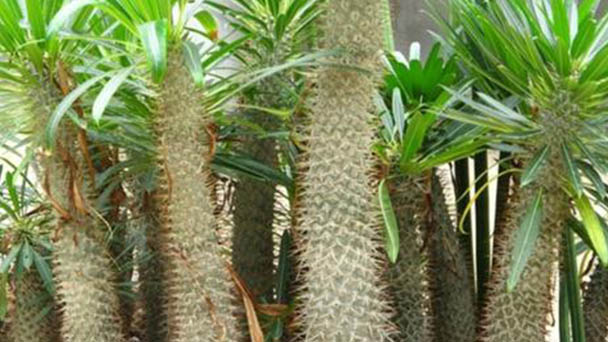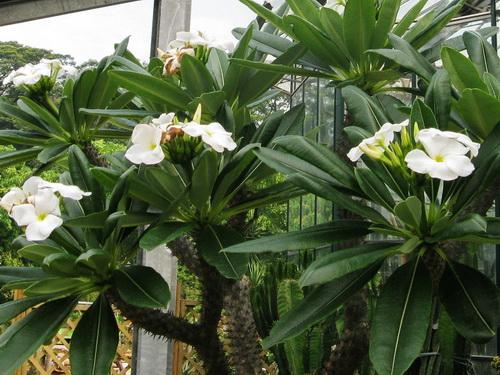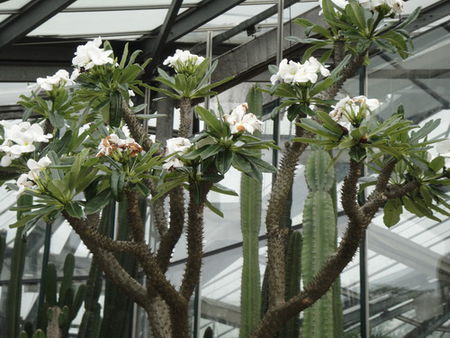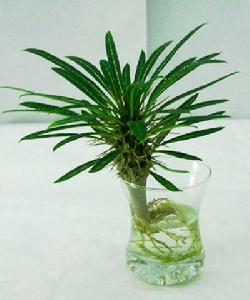Madagascar Palm (Pachypodium Lamerei) Profile
Written by Maggie
Oct 30 2021

Madagascar Palm is a succulent tree genus of oleander family, with brownish green cylindrical stems, fat and straight, densely bearing 3 hard spines in a cluster, thicker and slightly shorter. Madagascar Palm cauline apex fascicular emerald green long broad-linear leaves, pointed, petiole and vein light green, white flowers.
Madagascar Palm is a succulent plant of the family Oledosus. It is suitable for keeping in air-conditioned rooms and can purify the air. madagascar palm is heat-resistant, easy to feed, and beautiful in shape, especially suitable for today's hot weather. And the stomata on the fleshy stem, which closes during the day and opens at night, can absorb carbon dioxide while also producing oxygen, increasing the concentration of negative ions in the indoor air.
Madagascar Palm is a species of tree of the genus Diptera with a trunk height of 8m, which is distributed in tropical dry and wet climate regions.
Madagascar Palm Picture

Madagascar Palm Morphological Characteristics
Madagascar Palm plants are tall, up to 6 meters high and covered in spines. Seen from a distance in the African desert with a wide field of vision, they are overbearing and have the momentum of overtaking the crowd. Madagascar Palm appearance is peculiar, can make potted ornamental, put a pot on the table, it is said to have the effect of letting the small people around you retreat. Madagascar Palm is a rare species of succulent plants, and it is one of the most valuable species in the world of about 25 species of Madagascar Palm.
Madagascar Palm has brown green cylindrical stems, which look like an oversized mallet and are dry and fat, and hence the genus name. There are three thick and short hard spines in a cluster. The wholeMadagascar Palm looks like a kind of weapon in ancient China -- mace. Stem is apical caespitose linear leaf blade, emerald green, petiole and vein light green;White flowers, long blooming.
Madagascar Palm is an arboreal succulent plant with a thorny trunk 8m high. Dark green leaves are15 -- 20cm long, clustered at the apex of the stem. The stem epidermis is brown, the young Madagascar Palm stem is a papilloma tumor block, the top of the tumor block has 3 spines, 2 long and 1 short, very sharp. White flowers resembling those of a common oleander. Stem is usually unbranched, cylindrical, fleshy, brownish green with dense clusters of 3 stiff spines. Leaves of Madagascar Palm are clustered apically on stems, linear to lanceolate, dark green, 25-40 cm long. Summer flowering, flower tall foot saucer shape, milky white, yellow throat, flower diameter about 11 cm. (Find more Climbing Plants with Flowers here.)
Madagascar Palm stem is robust, covered with thorns, linear leaves such as the feathers on the helmet worn by the brave and brave general, the whole plant looks like a powerful and strong overlord, hence the name. Small Madagascar Palm can be placed indoors windowsill, sundeck and other places of cultivation.
Madagascar Palm has a peculiar appearance, and it is a rare variety of succulent plants.
Madagascar Palm Ecological Habits
Madagascar Palm enjoys warm, sunny weather and drought tolerance. Madagascar Palm enjoys warm, sunny, hot and humid environments, as well as drought tolerance.
Madagascar Palm is adapted to tropical dry and wet seasons.
How to Care for Madagascar Palm
Madagascar Palm Temperature Care
Madagascar Palm likes warmth, and the optimum temperature for growth is 20~25°C. When the temperature was below 5°C, the leaves fell off. Freezing damage occurs below 0°C. Madagascar Palm has high-temperature resistance, but above 35°C when the leaf will wither and fall off. The Madagascar Palm cold tolerance is slightly poor, and the overwintering temperature is best maintained above 12°C. Because the light hall was originally born in the region of dry summer and winter rain in West Africa, and the dry season is quite long, thus the summer leaves dormant, and is very sensitive to humidity and sultry, if you do not pay attention to it is easy to rot, should be placed in a cool place, and strengthen ventilation.
Madagascar Palm Lighting
Madagascar Palm enjoys sunny environments, even in the hot summer season, there is no need for shade. Although they can grow in semi-light conditions, they do not grow as well as plants in full light. Guangtang is shading in summer, especially when it is raining and sunny for a long time, so as not to burn the stem.
Madagascar Palm Watering
Madagascar Palm drought resistance, avoid water accumulation. Watering in the growing period should grasp the principle of "1000 wet alternating with dry", and water conservation should be carried out only after the basin soil is dry, so as to prevent the basin soil from being too wet or waterlogged, otherwise it is easy to cause rotten roots, but it should not be too dry, otherwise it will also cause fallen leaves. During dormancy in winter, leaves fall off. Water should be controlled to keep the basin soil relatively dry. Unlike other Raul plants, Madagascar Palm is dormant after falling leaves in summer and should be watered sparingly to avoid spoilage.
Madagascar Palm Fertilizer
Spring and autumn growing season should be every 15 ~ 20 days to apply a thin fertilizer, promote plant growth. Stop fertilizing during dormancy in summer and winter.
Madagascar Palm Soil Care
Madagascar Palm likes rich, loose and well-drained sandy loam. The substrate can be made up of leaf sapling soil, garden soil, coarse sand and other materials, and mixed with appropriate calcareous materials. When planting, Madagascar Palm should put a few decayed cow dung in the basin bottom to make base fertilizer. Potted plants should be turned every 1 to 2 years in the spring and fall when growth is slow.
Madagascar Palm Propagation
Madagascar Palm is often used for seeding and plant division propagation, while African palm mainly relies on seed propagation.
Madagascar Palm Division Propagation
Let the seedbed fully dry (generally 3 days or so), and then pour a permeable, watering when adding some fungicides, such as dioxone, methyl tobujin, so repeated twice. Three to four months after the emergence of seedlings, seedlings about 20 cm high, should be changed to facilitate its growth. When changing the pot, we should pay attention to reduce root damage, and avoid pinching the root neck, because it is the most vulnerable to injury, resulting in plant rot. Madagascar Palm grows rapidly, small seedlings should be planted in large pots. madagascar palm trees are strong. In daily cultivation, the culture soil should be prepared with peat, perlite and coarse sand in the ratio of 12:1:2, and the moisture should be wet as well as dry. In addition to the summer seedling slightly shading, to carry out full sunshine management. In the whole growth cycle to ensure adequate supply of fertilizer and water, small seedling stage according to the ratio of nitrogen, phosphorus, potassium = 1:1:1, every half a month; After the seedling, according to N, P and K = 1.2:0.8:1, water once every 10 days.
Madagascar Palm Seed Propagation
In late spring. Seeds of Madagascar Palm should be immersed in water for 12 hours before sowing, and covered with plastic film or glass on the pot after sowing. The suitable temperature for germination is 19 ~ 20T:, and it can germinate after 7 days, and the germination rate reaches more than 80%.
It is difficult for the propagation of Madagascar Palm to be used as rootstock for grafting and breeding, and the stem of appropriate thickness can be cut as scion. After connecting, tie the interface tightly, and then loosen it after healing and germination of new buds.

Madagascar Palm Disease Control
Madagascar Palm is harmful to root rot, which is often caused by underground pests after eating. The underground pests should be controlled. Madagascar Palm also has whitefly, red spider and so on insect pest harm. Sometimes stem rot harm, can be used 10% antimicrobial agent 401 acetic acid solution 1000 times the liquid spray. The insect pest has scale insect harm, use 50% dichlorvos emulsion 1000 times liquid spray kill.
Madagascar Palm Root Rot
It mainly occurs after basin replacement and in poorly drained basins. Therefore, attention should be paid to reduce damage when changing pots, while avoiding over-watering.
Madagascar Palm Blight Disease
The tender leaf tip first appeared yellow spots, then the color turned brown, black, deformity, serious when the whole leaf dried off. The main reason is that the proportion of nitrogen, phosphorus and potassium is out of balance, and the growth trend is too prosperous. Therefore, the proportion of liquid fertilizer should be prepared, and the supply of fertilizer and water should be ensured throughout the growth cycle. At the small seedling stage of Madagascar Palm, the ratio of nitrogen: phosphorus: potassium = 1:1:1 should be poured every half a month; After large seedlings, water them every 10 days according to N: P: K = 1.2:0.8:1.At the same time, attention should be paid to the early stage of the disease, especially when it is cloudy and rainy.
Madagascar Palm Varieties
1. Africa Palm Incongrination {R Lamerei {.cristata)
It is the compound variety of African overlord tree. Plant height 30 ~ 40 cm, the stem flattened was a comb shape, stout and hypertrophic, brown green, dense living 3 a cluster of hard thorns. Leaves clustered at coronal apically.
2. P. Namaquanum
Also known as the Stick Maul Tree.Arbor-shaped fleshy plants, plant height 1 ~ 3 meters. Stems usually unbranched, covered with brown spines 3-5 cm long. Leaves clustered apically, lanceolate, rosette, pale green, margin undulate, ca. 12 cm long, shed in the dry season. Summer flowers, canicles, yellow-green or purplish red, with yellow stripes inside, born in the axils of leaves.
3. Asian-Albanian boundary (P. Geayi)
Stem long and spiny.Leaves slender, blue-green, gray hairs, about 30 cm long, gray hairs on the back of the leaves.Flowers white.
Madagascar Palm Distribution
Introduced and cultivated in China, originally produced in South America and North America, Madagascar Palm has been widely cultivated. Because of the drought, Madagascar Palm grew into a cactus-like shape.
Madagascar Palm Uses
Cleans the air
Madagascar Palm is suitable for an air-conditioned room, which can purify the air. Madagascar Palm is heat-resistant, easy to feed, and beautiful in shape, especially suitable for today's hot weather. And the stomata on the fleshy stem, which closes during the day and opens at night, can absorb carbon dioxide while also producing oxygen, increasing the concentration of negative ions in the indoor air.
Potted Madagascar Palm
Madagascar Palm has a peculiar appearance, and it is a rare variety of succulent plants. The introduction results showed that the three varieties of fleshy and pulpy flowers had good growth characters, strong adaptability and high ornamental value. Madagascar Palm is an ideal indoor potted flower and an ideal environment for flower lovers.

Read Next:
Top 20 Climbing Plants with Flowers for Your Garden
Latest Updated
- Benefits of Bugleweed - 7 Science-backed Health Benefits
- Bugleweed Dangers & Side Effects - Is It Poisonous?
- How to Plant Evergreen Trees - What You Should Know
- When to Plant Evergreens - Grow Guide for Evergreen Trees
- 12 Wonderful Evergreen Shrubs for Your Garden
- 12 Popular Evergreen Plants with Pictures for Beginners
- When And How To Prune A Lilac Bush Like a Pro
- How to Grow & Care for Lilac Vine (Hardenbergia Violacea)
- Japanese Lilac Tree (Syringa Reticulata) Care & Propagation Guide
- Shumard Oak Pros and Cons - What to Know
Popular Articles
- Winter maintenance of Antirrhinum Majus
- How to Grow Terminalia Mantaly Tree
- How to Grow and Care for Crossostephium Chinense
- How to grow Antirrhinum Majus in spring
- Peristeria Elata (Dove Orchid) Profile: Info & Care Guide
- Underwatered Snake Plant (Sansevieria Trifasciata) - Signs And How To Fix
- How to Care for Brazilian Jasmine Plant (Mandevilla Sanderi)
- How to Grow & Care for Graptopetalum Purple Delight in Summer
- Rosa Chinensis (China Rose): Plant Growing & Care Tips
- How to Care for Baby Sun Rose (Aptenia Cordifolia)